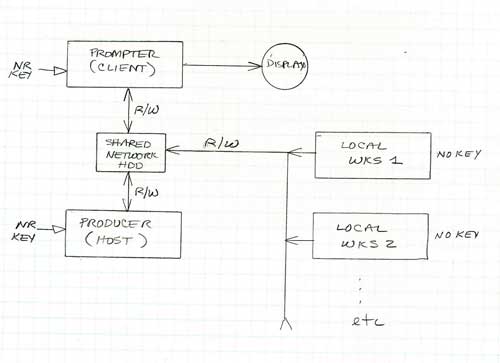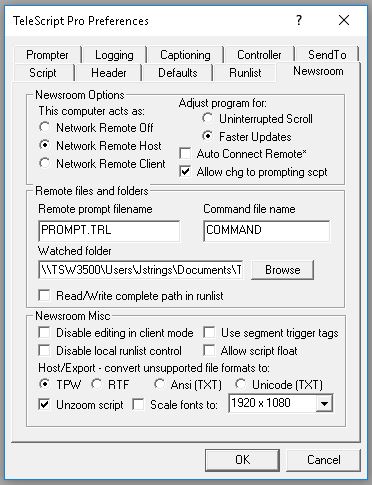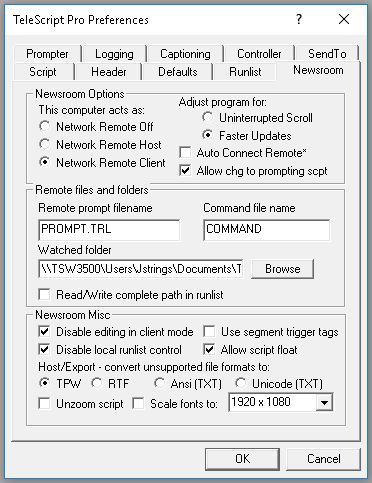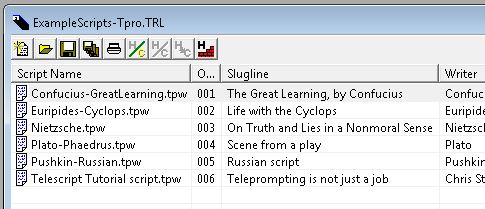Using TeleScript Pro HOST/CLIENT (Newsroom)
METHOD 1 -- One Host, One Prompter Client, Many writer workstations
This section describes classic Newsroom setup for TeleScript ProNEWS.
Remote Client - TeleScript ProNEWS Security Key required.
- Maintains a Runlist and monitors for changes (deletions, additions, and changes in order.)
- Creates the teleprompter display
- Allows an operator to control teleprompter speed.
- Informs the Host of current status.
Remote Host - TeleScript ProNEWS Security Key required.
- Collects scripts from workstations.
- Creates and updates the runlist.
- Rebuilds the runlist when changes are made.
- Sends remote update notification to the Client.
Remote Workstations - No Security Key required
- Allows workstation users (in "Edit Only" mode) to create and store scripts in TPW format.
Basic Setup
Set up a shared folder by the Remote Host, Remote Client and Remote Workstations. TeleScript Pro is capable of using network names such as \\Dell1300\Telescript\Remote. Or, you may Map the network drive to a letter. For the sake of this discussion, the Remote Folder will be designated as the "M-Drive" (M:\). By default, the Remote Folder is created at "C:\User\YourUserAccount\Documents\TeleScriptProData\Remote". It is advisable to use a physical location on the Remote Client (as opposed to the Host Computer) as the shared folder. Your network administrator can map thie folder to be shared as "M:\" on workgroup computers.The path name seen by both Host and Client is M:\Remote. DO NOT STORE THE ORIGINAL COPIES OF SCRIPTS IN THE REMOTE FOLDER. Instead, create folders which are available to each workstation, and ONLY to that workstation. Your IT specialist should be able to perform this task.
Set sharing and permissions as follows:
M:\Scripts\WriterA, M:\Scripts\WriterB, etc. - accessible and visible to Remote Host and Specified Workstation; i.e., M:\Scripts\WriterA is visible ONLY to WriterA and Remote Host; M:\Scripts\WriterB is visible only to WriterB and Remote Host, etc.
M:\Remote -- visible and accessible ONLY to Remote Host and Remote Client
Use TeleScript ProNEWS menus select "Tools/Options" then click the Newsroom tab to display the configuration dialog:
Configure ONE machine as the Remote Host.
This machine will create and maintain the Remote Runlist, and will collect the scripts to be prompted from their original locations on the network. In the Newsroom Options dialog, make these entries:
- Under Newsroom Options, click "Network Remote Host"
- Click "Adjust program for: Faster Updates"
- Under "File Exchange", set the Remote prompt filename. You may select any legal Windows filename, but it must be the same on both Host and Client.
- "Command file name" may be left at "COMMAND", the default.
- Set the Remote Path to the shared network folder you created in basic setup.
- If you've properly mapped a drive, it won't matter if the "Write and read complete path in remote runlist" is checked.
- Under "Newsroom Misc", check TPW for the file format for converted scripts.
- Do not check the box beside "Scale fonts when saving."
Configure ONE machine as Remote Client.
This machine will monitor the Remote Path for changes in scripts and/or the Remote Runlist. IN the Newsroom Options dialog, make these entries:
- Unser Newsroom Options, click "Network Remote Client"
- Click "Adjust program for: Faster Updates"
- Under "File Exchange", enter the same file specs as you have in the Remote Host configuration.
- "Disable editing in client mode" and "Disable local runlist control in client mode" are options that depend upon the level of training and trust afforded the teleprompter operator. Set them accordingly.
In addition, on the client's Defaults tab, uncheck "Apply selected attributes to scripts as they are loaded"
A Remote Workstation may be any computer logged onto the network. No configuration is required for Remote Workstation computers. However, the following steps are recommended:
- The Network administrator should create the writer's folder and set permissions so that only the writer's individual folder is accessible.
- In the typical TeleScript ProNEWS scenario, each workstation writes to it's own folder. You can set the default script folder in TeleScript ProNEWS Preferences (Tools/Options -- Script).
- You may also set the default font, colors and average line length.
The writers at Remote Workstations are free to load, view, edit and save scripts in their folder -- changes will NOT be reflected in the HOST/CLIENT computers until the Remote Host takes action (described below.)
NOTE: Using personal folders for each writers scripts prevents one writer from overwriting another's edits.
Initializing Remote Operation
Suppose that WriterA has written ScriptA1, ScriptA2, and ScriptA3; WriterB has written ScriptB1, ScriptB2, etc. Each writer has saved his scripts into his personal folder. Each time he edits a script, he will re-save it into their personal folder. (Note: DOC files are Locked when MS-Word opens them. No other application can access a locked file. Be sure writers using MS-Word CLOSE files after editing. TeleScript ProNEWS shares files and scripts can remain open, and still be read by other users. Best practice is to edit and close in any case.
The Remote Host Creates a Runlist
The Remote Host navigates to each writer's folder. He loads these scripts:
- M:\Scripts\WriterA\ScriptA1.TPW
- M:\Scripts\WriterA\ScriptA2.TPW
- M:\Scripts\WriterA\ScriptA3.TPW
- M:\Scripts\WriterB\ScriptB1.TPW
- M:\Scripts\WriterB\ScriptB2.TPW
- M:\Scripts\WriterB\ScriptB3.TPW
- .
- .
- M:\Scripts\WriterC\ScriptXX.TPW
The Remote Host CONNECTS
Once he has created the runlist collected from the various personal folders, the Remote Host CONNECTS, either by selecting Tools/Newsroom/Connect, or clicking the Connect Icon (H/C) in the runlist header. When the HOST connects, here's what happens:
- The host makes a COPY of each writer's script in the RemoteFolder.
- The host writes the file (PROMPT.TRL unless it was renamed in configuration.)
Note that the Remote Host remembers where each script came from -- that is the path to the writer's personal folder. The Remote Folder contains ONLY A COPY -- not the ORIGINAL.
The Remote Client Connects
The Remote may now connect... likewise, from the Tools/Newsroom menu item or by clicking the icon on the runlist header. The Client will load the specified .TRL along with a copy of each script. The Remote Client operator can send the runlist to the prompter, and can commence scrolling, or any other function designated to the Remote Client operator.
The HOST remains in control of the runlist. ONLY THE HOST CAN CHANGE THE RUNLIST AND ONLY THE HOST CAN WRITE COPIES OF SCRIPTS INTO THE REMOTE FOLDER! This is VERY IMPORTANT.
How changes are handled
Suppose WriterA makes and edit in ScriptA1. This changed file is stored in M:\Scripts\WriterA\ScriptA1.TPW. In order for this change to be reflected in the Remote folder, the Remote Host operator should do the following:
- Click Tools/Newsroom/Rebuild (<Ctrl+Alt+W>), or clicks the rebuild icon in the Runlist Toolbar. This replaces the copy of ScriptA1 in the Host's local (in memory) runlist with the revised ScriptA1, but it does NOT YET update the Remote.
- 2. The Remote Host Updates the Remote Runlist by clicking Tools/Newsroom/Update (<Ctrl+W>), or by clicking the Update icon in the runlist toolbar. This writes the changed file into the remote folder and re-writes the .TRL. When the CLIENT is notified of a change in the Remote folder, an automatic update is performed.
NOTE THAT A SCROLLING SCRIPT (YELLOW OR GREEN ARROW) CANNOT BE CHANGED. A stopped script (Red Arrow) on prompter CAN be changed remotely.
Flow Diagram of Method 1

METHOD 2 - One client, any number of workstations -- no HOST
This method is easier in one way -- harder in another. It's easier to set up and somewhat easier to understand. It's harder in that it requires vigilance. Each workstation can write into the remote folder. There's always the possibility of one writer OVER-writing another's edits.
Designate the Prompting Client Computer. Set up the Remote folder, lets say, again, M:\Telescript\Remote. You can still use PROMPT.TRL as the watched runlist file.
All scripts should be stored in the remote folder. They can be any type of file that TeleScript Pro recognizes... TPW, RTF, DOC, DOCX, etc. I recommend using TeleScript Pro for edits and storing scripts in TPW format... you won't encounter file format inconsistencies. You can also correctly format scripts for prompting so there are no tweak required on the Client side.
Prompting Client (before "connecting") must create the show runlist from the files in this folder. Manually "Save As Runlist.." PROMPT.TRL.
Now, activate Runlist monitoring using Tools/Newsroom/Connect, or click the "connect" icon in the runlist toolbar. The Client will re-load the runlist your just saved as PROMPT.TRL. It is now watching for changes, not only in PROMPT.TRL, but also in the SCRIPTS stored in the remote directory.
Each writer/editor workstation must be able to see the Remote directory. If WriterA needs to make a change to ScriptA.TPW, he should open M:\Telescript\Remote\ScriptA.TPW, make the required changes, then Save the script. WriterA should CLOSE the script as soon as edits are completed and saved.
The change will be reflected on the remote client. Again... scrolling scripts (yellow or green arrow) cannot be changed... stopped scripts (red arrow) can be changed remotely.
Workstation computers should NOT load the runlist, but rather should OPEN a script for editing, make changes, save the script.
Cautions for METHOD 2:
1. As mentioned, two workstations can open the same script and compete for "most recent version." There is no mechanism for preventing this... Windows allows read/write sharing of files. We don't lock files because it leads to locked file errors... better simply to use caution.
2. If a writer does not save frequently while editing there is the hazard of losing changes in the event of a computer issue. If the writer DOES save frequently, the Remote Client will update constantly and prompting smoothness may be compromised.
3. Unsaved changed from a workstation will NOT reflect in the Remote Client.
4. Files locked by MS-Word can't be accessed for reading by any other application. If TPro encounters a locked file, it marks the file as unusable.




